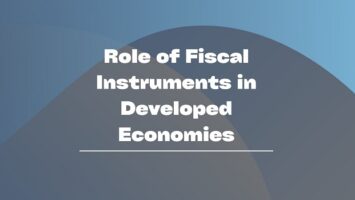Table of Contents
Burden of Public Debt:
The burden of public debt refers to the sacrifice it will impose and have effects on the community through a rise in taxation, necessitated at the time of repayment and for paying the annual interest on the government loans.
The Concept of the Burden of Public Debt:
The concept of the burden of public debt is an extremely vague term. However, a distinction is made between financial burden or primary burden and real burden or secondary burden. When a debt is incurred by the government, the level of taxation in the economy has to be increased in order to meet the interest charges so long as the debt continues to exist. To the extent of the increase in the tax level, the income of the people is transferred to the government. The consequent loss in the income of the people may be called the financial burden of public debt. To put it in the words of David M. C. Wright, “The financial burden of the national debt is to be measured by the effects of the interest charges and the taxes levied to meet them. The relation which the taxes or interest bear to the national money income is the question of primary importance.”
The higher level of taxation caused by the rising public debt may have some repercussions on the economy in the form of adverse effects on the capacity and willingness to work and on the capacity and willingness to save. These effects may be called real burden or secondary burden of public debt. In this context Prof. A. P. Learner also observed, “An increase in national debt can make the owner of the Government bonds less willing to work, once of the reason to put away for the rainy day is weakened…..because there is more put away already for rainy day.”
The concept of the burden of public debt has also been explained in terms of the direct and indirect burden of public debt. A direct money burden is measured by the extent of money payment involved and the rise in taxation needed. The direct real burden is equal to the loss of economic welfare, (i.e., the sacrifice of goods and services made by the taxpayers) on account of the direct money burden of increased taxation. The indirect burden of public debt, however, refers to the extent of adverse effects of increased taxation on the level of production.
Again, the concept of burden is sometimes explained in terms of the notion of abstinence or pain-cost doctrine and opportunity cost. When a loan is raised by the government, resources are transferred from private hands to the government and those who contribute to government loans abstain from consuming current income and undergo the pain of abstinence which may be called a burden caused by the incurring of public debt. On the basis of the principle of opportunity cost, it is said that public debt entails a burden because, when a loan is raised by the government, people are prevented from putting their resources into other purposes, the marginal productivity of which might be more.
However, the concept of burden based on the notion of abstinence and opportunity cost is not quite acceptable, if people contribute to public loans voluntarily. When people voluntarily lend to the government, it means by investing in government securities they are moving to a preferred position on the utility surface.
In estimating the burden of public debt, it should be taken into account, as to whether the debt is productive or unproductive, and whether it is internal or external, and also the price level in the economy. If the price level falls, the value of money raises and vice versa. Hence, if the price level falls, the real burden of interest increases and vice versa.
Estimation of the Burden of Public Debt:
There are various ways of estimating the comparative burden of public debts. However, the conclusion is that all things considered, not one method alone should be adopted, but a combination of the various methods. Probably the most useful are the methods of-
(1) Taking the ratio of national debt to national wealth and income.
(2) The percentage of expenditure on the debt services to total ordinary expenditure.
A combination of these two methods has been considered useful for estimating the relative burden of public debt.
Burden Controversy:
The burden controversy is one of the oldest subjects of academic discussions. Whether public debt is a net economic burden has been a subject of great debate since the days of mercantilists, down to the present day. The burden controversy, it appears, had reached its logical end in the pronouncements of A. C. Pigou, A. P. Lerner, and Alvin H. Hansen and their views remained unchallenged for quite a long time. The Keynesian literature dismissed the classical burden thesis of public debt and there was little dissent to this view. But, with the publication of James M. Buchanan’s “Public Principles of Public Debt” in 1958, the ball was again set rolling and once again the debate became lively. Since, both, economists and politicians came out with highly controversial views regarding the burden of public debt.
Classical Views on the Burden of Public Debt
Modern Theory of the Burden of Public Debt
Main Propositions of Modern Theory of Public Debt
Conclusion:
What emerges from the foregoing discussion of the burden of public debt is that the existence of a large debt is neither an evil nor a blessing in itself. It has both adverse effects and favorable effects on the economy. It is an instrument of public policy, but it is one which should be used with care.
The problems with which the controversy is concerned are-
(1) The measurement of the burden.
(2) The costs and benefits of the public debt.
(3) The inter-generation distribution of the burden of public debt.
The academic views about these specific aspects have been changing from time to time.
Mercantilists favored public debt creation as they found that the State raised loans for beneficial investment. The early classical economists opposed public debt creation on the ground that government spending is wasteful and does not provide any benefit to the community. The latter classical economists took into consideration the mutuality of advantage of public debt to the government and the lenders to the government and they had quite liberal views about the creation of public debt.
The modern economists led by Keynes completely dismissed the question of the burden of the internal public debt on the basis of income-creating potentialities of public debt. Their contention is that it is the external debt that imposes a burden and not the internal debt. Intergeneration distribution of the burden of public debt is also ruled out by modern economists.
But, in recent years, some economists have refuted the no-burden thesis and have tried to establish the fact that public debt creation imposes a burden, and also the burden can be passed on to future generations. There are others who attack this line of reasoning and advance their arguments in favor of the no-burden thesis. However, even the staunch supporters of the no-burden thesis do not say that the growth of public debt does not matter. As Lerner has said, “A statement that public debt does not matter must be understood in the same sense as when a man who finds that rumor has converted a twisted ankle into a broken neck tells his friends that he is perfectly all right.” All that the no-burden thesis says is that the burden of public debt need not be a matter of concern so long as the nation’s income continues to rise. The central point implicit in all the discussions about the burden of public debt need not cause any concern so long as the national income rises adequately.









Comments (No)